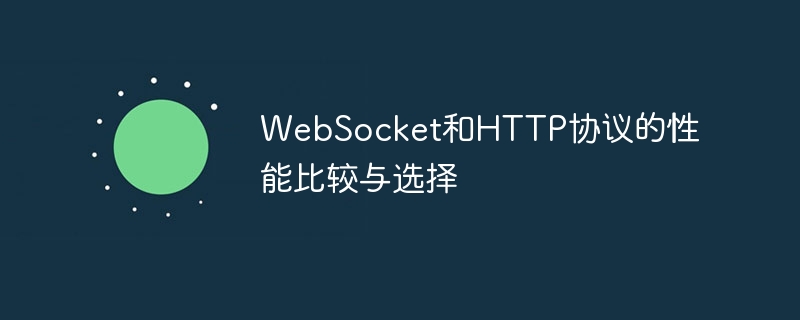Home >Backend Development >PHP Tutorial >Performance comparison and selection of WebSocket and HTTP protocols
Performance comparison and selection of WebSocket and HTTP protocols
- WBOYWBOYWBOYWBOYWBOYWBOYWBOYWBOYWBOYWBOYWBOYWBOYWBOriginal
- 2023-10-15 10:04:421265browse

Performance comparison and selection of WebSocket and HTTP protocols
Introduction:
In web application development, whether it is real-time chat application, multi-player online game or real-time Data transmission, network connection stability and transmission efficiency are all one of the key elements. Currently, WebSocket and HTTP are two commonly used network transmission protocols, and they have large differences in performance and functions. This article will focus on the performance comparison between WebSocket and HTTP protocols, and provide some specific code examples so that developers can choose based on actual needs.
1. WebSocket Protocol
WebSocket is a lightweight protocol based on the TCP protocol. It achieves real-time communication between the client and the server by performing full-duplex communication on the same persistent connection. data transmission. Compared with traditional HTTP connections, the WebSocket protocol has the following advantages:
- Reduce network traffic: WebSocket requires an HTTP handshake when establishing a connection, but subsequent communications will use more lightweight protocol, reducing redundant HTTP header information transmission, thereby reducing network traffic.
- Real-time: The WebSocket protocol allows the server to push messages to the client in real time without the client actively requesting the server to obtain data every time, which greatly reduces the server load and improves the user experience.
- Lower latency: Since the WebSocket protocol is full-duplex communication, the client and server can send and receive data at the same time, reducing transmission delays and making real-time performance higher.
2. HTTP protocol
HTTP protocol is currently the most widely used protocol on the Internet. It uses a request-response model. The client sends a request to the server, and the server returns corresponding data according to the request. The characteristics of the HTTP protocol are as follows:
- Simple and easy to use: The HTTP protocol is very simple to use. You only need to define the request method and request headers, and then return data through status codes and response headers.
- Stateless: The HTTP protocol is stateless, each request is independent, and the server does not retain the client's status information. This means that each request requires re-establishing the connection, which is not suitable for scenarios that require real-time communication.
- High compatibility: Due to the widespread use of the HTTP protocol, various languages and frameworks provide HTTP client and server implementations, which are more convenient to use.
3. Performance comparison and selection
- Throughput: Compared with HTTP protocol, WebSocket can handle more requests per unit time and has higher performance throughput.
- Latency: Because WebSocket is full-duplex communication based on persistent connections, WebSocket has lower latency than the HTTP protocol that requires re-establishing the connection every time.
- Applicable scenarios: If the application requires high-real-time communication, such as online games, real-time chat, etc., WebSocket is a better choice. For traditional web page requests and responses, the HTTP protocol can still be used.
The following are some specific code examples for developers to better understand and practice:
- Use WebSocket to establish a connection:
var socket = new WebSocket("ws://example.com/socket");
socket.onopen = function() {
console.log("WebSocket 连接已建立");
};
socket.onmessage = function(event) {
console.log("接收到消息:" + event.data);
};
socket.onclose = function() {
console.log("WebSocket连接已关闭");
};- Use HTTP to send requests:
var xhr = new XMLHttpRequest();
xhr.open("GET", "http://example.com/data", true);
xhr.onreadystatechange = function() {
if (xhr.readyState === XMLHttpRequest.DONE && xhr.status === 200) {
console.log("接收到响应:" + xhr.responseText);
}
};
xhr.send();It is very important to choose the appropriate network protocol according to actual needs. WebSocket and HTTP protocols have their own characteristics, advantages and disadvantages, and developers need to choose the appropriate network protocol according to the application. Scene selection. If you need real-time communication and low latency, you can choose the WebSocket protocol; if you only need the traditional request and response mode, you can continue to use the HTTP protocol. In actual development, the two can also be combined according to specific circumstances to achieve the best performance and user experience.
Conclusion:
There are obvious differences in performance and functionality between WebSocket and HTTP protocols. The WebSocket protocol is suitable for application scenarios that require real-time communication and low latency, while the HTTP protocol is suitable for traditional request and response modes. Developers should make trade-offs based on actual needs when choosing a protocol and apply them flexibly to provide a better user experience.
The above is the detailed content of Performance comparison and selection of WebSocket and HTTP protocols. For more information, please follow other related articles on the PHP Chinese website!

